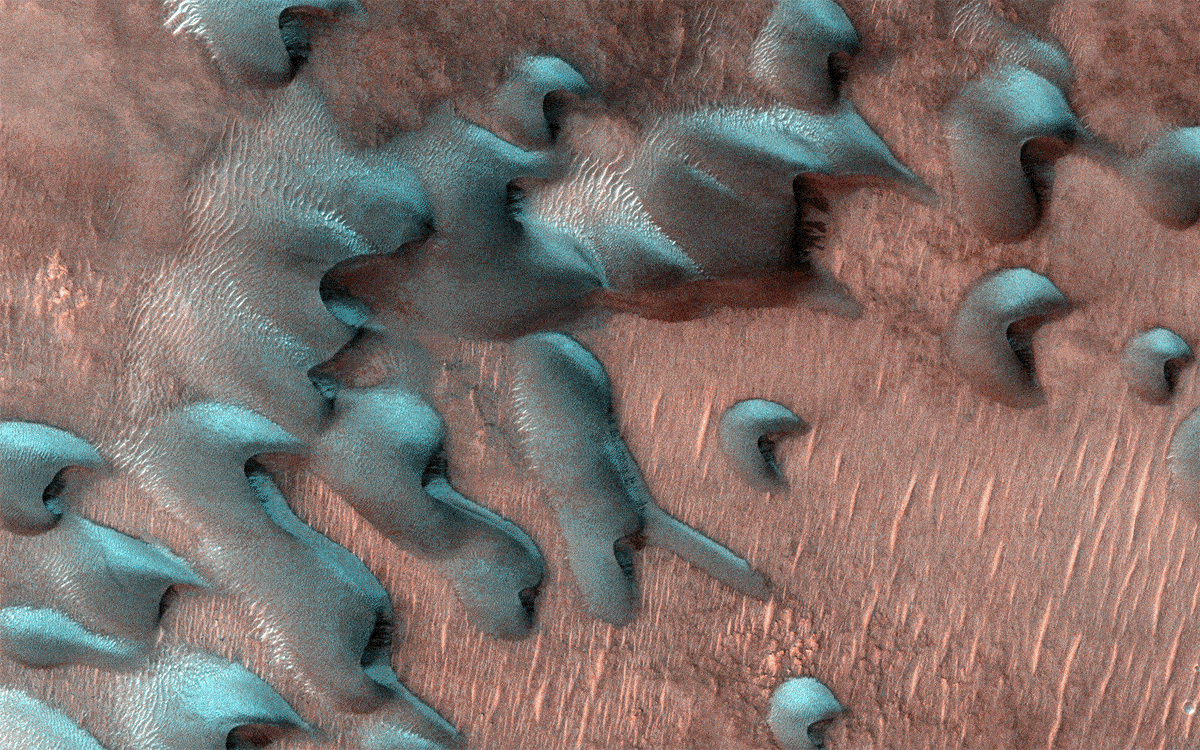
الثلج على شكل مكعب ، والمناظر الطبيعية الجليدية ، والصقيع كلها جزء من أبرد موسم على الكوكب الأحمر.
عندما يأتي الشتاء[{” attribute=””>Mars, the surface is transformed into a truly otherworldly holiday scene. Snow, ice, and frost accompany the season’s sub-zero temperatures. Some of the coldest of these occur at the planet’s poles, where it gets as low as minus 190 degrees Fahrenheit (minus 123 degrees Celsius).

The HiRISE camera aboard NASA’s Mars Reconnaissance Orbiter captured these images of sand dunes covered by frost just after winter solstice. The frost here is a mixture of carbon dioxide (dry) ice and water ice and will disappear in a few months when spring arrives. Credit: NASA/JPL-Caltech/University of Arizona
Cold as it is, don’t expect snow drifts worthy of the Rocky Mountains. No region of Mars gets more than a few feet of snow, most of which falls over extremely flat areas. And the Red Planet’s elliptical orbit means it takes many more months for winter to come around: a single Mars year is around two Earth years.
https://www.youtube.com/watch؟v=jxVfj-Gs2y8
يتساقط الثلج ويتشكل الجليد والصقيع على سطح المريخ أيضًا.[{” attribute=””>NASA’s spacecraft on and orbiting the Red Planet reveal the similarities to and differences from how we experience winter on Earth. Mars scientist Sylvain Piqueux of JPL explains in this video. Credit: NASA/JPL-Caltech
Still, the planet offers unique winter phenomena that scientists have been able to study, thanks to NASA’s robotic Mars explorers. Here are a few of the things they’ve discovered:
Two Kinds of Snow
Martian snow comes in two varieties: water ice and carbon dioxide, or dry ice. Because Martian air is so thin and the temperatures so cold, water-ice snow sublimates, or becomes a gas, before it even touches the ground. Dry-ice snow actually does reach the ground.
“Enough falls that you could snowshoe across it,” said Sylvain Piqueux, a Mars scientist at NASA’s Jet Propulsion Laboratory in Southern California whose research includes a variety of winter phenomena. “If you were looking for skiing, though, you’d have to go into a crater or cliffside, where snow could build up on a sloped surface.”

HiRISE captured these “megadunes,” also called barchans. Carbon dioxide frost and ice have formed over the dunes during the winter; as this starts to sublimate during spring, the darker-colored dune sand is revealed. Credit: NASA/JPL-Caltech/University of Arizona
How We Know It Snows
Snow occurs only at the coldest extremes of Mars: at the poles, under cloud cover, and at night. Cameras on orbiting spacecraft can’t see through those clouds, and surface missions can’t survive in the extreme cold. As a result, no images of falling snow have ever been captured. But scientists know it happens, thanks to a few special science instruments.
NASA’s Mars Reconnaissance Orbiter can peer through cloud cover using its Mars Climate Sounder instrument, which detects light in wavelengths imperceptible to the human eye. That ability has allowed scientists to detect carbon dioxide snow falling to the ground. And in 2008, NASA sent the Phoenix lander within 1,000 miles (about 1,600 kilometers) of Mars’ north pole, where it used a laser instrument to detect water-ice snow falling to the surface.
https://www.youtube.com/watch؟v=mjuwZKEl-XU
يمكن لعلماء ناسا قياس حجم وشكل توزيع جزيئات الثلج ، طبقة تلو طبقة ، في العاصفة. مهمة قياس الهطول العالمي هي مشروع ساتلي دولي يوفر الجيل التالي من عمليات الرصد للمطر والثلوج في جميع أنحاء العالم كل ثلاث ساعات. الائتمان: مركز جودارد لرحلات الفضاء التابع لناسا / رايان فيتزجيبونس
مكعبات الثلج
نظرًا لكيفية ارتباط جزيئات الماء ببعضها البعض عندما تتجمد ، فإن رقاقات الثلج على الأرض لها ستة جوانب. ينطبق نفس المبدأ على جميع البلورات: الطريقة التي تنظم بها الذرات نفسها تحدد شكل البلورة. في حالة ثاني أكسيد الكربون ، ترتبط الجزيئات الموجودة في الجليد الجاف دائمًا بأربعة أشكال عند التجميد.
قال بيكيو: “نظرًا لأن جليد ثاني أكسيد الكربون له تماثل من أربعة ، فإننا نعلم أن رقاقات الثلج الجافة ستكون على شكل مكعب”. “بفضل أسلم مناخ المريخ ، يمكننا أن نقول أن رقاقات الثلج هذه ستكون أصغر من عرض شعرة الإنسان.”

التقطت كاميرا HiRISE هذه الصورة لحافة فوهة بركان في منتصف الشتاء. شكل منحدر الحفرة المواجه للجنوب ، والذي يتلقى قدرًا أقل من ضوء الشمس ، صقيعًا غير مكتمل ومشرق ، يظهر باللون الأزرق في هذه الصورة ذات الألوان المحسنة. حقوق الصورة: NASA / JPL-Caltech / جامعة أريزونا
جاك فروست يقضم في العربة الجوالة الخاصة بك
يمكن أن يشكل كل من الماء وثاني أكسيد الكربون صقيعًا على سطح المريخ ، ويظهر كلا النوعين من الصقيع على نطاق أوسع عبر الكوكب أكثر من الثلج. شاهدت مركبات الإنزال فايكنغ صقيعًا مائيًا عندما درسوا المريخ في السبعينيات ، بينما شاهدت مركبة أوديسي المدارية التابعة لناسا لوحظ تشكل الصقيع ويتسامي بعيدًا شمس الصباح.

التقط HiRISE مشهد الربيع هذا ، عندما قام جليد الماء المتجمد في التربة بتقسيم الأرض إلى مضلعات. يسمح ثلج ثاني أكسيد الكربون الشفاف لأشعة الشمس بالتألق وتسخين الغازات التي تتسرب عبر الفتحات ، مما يطلق مراوح من مادة أغمق على السطح (تظهر باللون الأزرق في هذه الصورة ذات الألوان المحسنة). حقوق الصورة: NASA / JPL-Caltech / جامعة أريزونا
نهاية الشتاء العجيبة
ربما يأتي الاكتشاف الأكثر روعة في نهاية فصل الشتاء ، عندما يبدأ كل الجليد الذي تم تكوينه في “الذوبان” والتسامي في الغلاف الجوي. أثناء قيامه بذلك ، يتخذ هذا الجليد أشكالًا غريبة وجميلة ذكَرت العلماء بها العناكبو البقع الدلماسيةو البيض المقلي، و جبنة سويسرية.
يتسبب هذا “الذوبان” أيضًا في انفجار السخانات: يسمح الجليد الشفاف لأشعة الشمس بتسخين الغاز تحتها ، وينفجر هذا الغاز في النهاية ، مما يؤدي إلى إرسال مراوح الغبار على السطح. بدأ العلماء بالفعل في دراسة هؤلاء المعجبين كوسيلة لمعرفة المزيد عنها في أي اتجاه تهب رياح المريخ.

“متعطش للطعام. طالب. متحمس محترف للزومبي. مبشر شغوف بالإنترنت.”




More Stories
مبدأ جديد رائد – اكتشف الباحثون الكوريون ظاهرة ثورية في البلورات السائلة
طلاب UCF يقومون بالتنقيب في موقع الإطلاق الأول في كيب قبل الذكرى السنوية الخامسة والسبعين
أول أشعة سينية في العالم لذرة واحدة